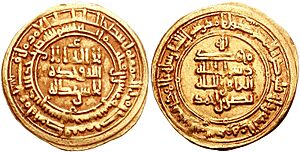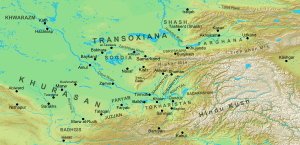Nasr II facts for kids
Quick facts for kids Nasr II |
|
|---|---|
| Emir of the Samanids | |

Coin of Nasr II, made in Nishapur, 933/4.
|
|
| Reign | 23 January 914 – 6 April 943 |
| Predecessor | Ahmad Samani |
| Successor | Nuh I |
| Born | 906 Bukhara |
| Died | 6 April 943 (aged 38) |
| Issue | Nuh I |
| House | Samanid dynasty |
| Father | Ahmad Samani |
| Religion | Isma'ili Shia Islam |
Nasr ibn Ahmad, also known as Nasr II, was a powerful ruler (called an amir) of a large area in Central Asia. This area included Transoxiana and Khurasan. He led the Samanid dynasty from 914 to 943. His time as ruler was a very successful period for the Samanid family. He was the son of Ahmad ibn Isma’il.
Contents
The Story of Nasr II

Becoming Ruler and Facing Challenges
Nasr became the amir when he was only eight years old. His father, Ahmad ibn Isma'il, was killed by his own guards in 914. Because Nasr was so young, a wise advisor named Abu Abdallah Jayhani helped him rule. This advisor was like a temporary leader.
Soon after Nasr became ruler, many rebellions started. The most serious one was led by his great-uncle, Ishaq ibn Ahmad, in Samarkand. Ishaq's sons also joined the fight. One son, Abu Salih Mansur, took control of Nishapur and other cities. Eventually, Ishaq was defeated. Another rebel general, Husayn ibn Ali al-Marwazi, was captured in 918.
Then, the general Ahmad ibn Sahl rebelled too. He was finally defeated in 919 and put in prison. After a few more small uprisings, the Samanid lands enjoyed about ten years of peace.
However, the edges of the Samanid empire became unstable. The Abbasids took back Sistan. Other areas like Ray and Tabaristan were taken by a group called the Alids. The Samanids tried to get these lands back. In 921, a general named Lili ibn al-Nu'man attacked Khurasan, but he was defeated.
Ruling the Empire
In 922, Nasr removed Abu Abdallah Jayhani as his main advisor. He replaced him with Abu'l-Fadl al-Bal'ami. Bal'ami mostly continued the same policies. In 928, a military leader named Asfar ibn Shiruya conquered Tabaristan and Ray.
In 930, Nasr's own brothers rebelled against him. They tried to make one of their brothers, Yahya, the new amir. But Bal’ami, Nasr's advisor, cleverly turned the brothers against each other, and the rebellion ended.
Another military leader, Makan ibn Kaki, took advantage of this. He seized Tabaristan and Gurgan from the Samanids. He even took Nishapur for a short time. But he had to leave these areas because the Samanids were a big threat. Makan then went to Tabaristan, where he was defeated by Mardavij, a leader from the Ziyarid dynasty. Mardavij then conquered the region.
In 933, Nasr showed he was ready to fight Mardavij. This made Mardavij give back Gurgan and pay tribute for Ray. A year later, Nasr sent Makan to fight Muhammad ibn Ilyas, who had rebelled. Muhammad was defeated and had to run away. Mardavij was killed by his own Turkic soldiers in 935. His brother, Vushmgir, took over.
Makan heard about Mardavij's death. He quickly left Kirman and became governor of Gurgan for Nasr. With Samanid soldiers, he tried to take back Tabaristan. Vushmgir fought back and even conquered Gurgan. But he faced pressure from another group, the Buyids. So, he made a deal with the Samanids, recognizing Nasr as his overlord and giving Gurgan to Makan.
From then on, Samanid armies often helped protect the Ziyarids from the Buyids. In 938, Abu Ali Jayhani, the son of Nasr's first advisor, became the main advisor. He held this job until 941.
Around this time, Makan and Vushmgir became friends. They decided to become independent from the Samanids. So, in 939, Nasr sent a Samanid army to attack Makan in Gurgan. After a long siege, Makan had to flee. The Samanid army followed him. In a battle in 940, the Samanid forces won. Makan was killed by an arrow, and his head was sent to Nasr in Bukhara.
Changes in Belief and Nasr's Final Years
In the 930s, a religious group called the Isma'ilis tried to convert people at the Samanid court. They were very successful. Many important officials became Isma'ili. According to some stories, Nasr himself became an Isma'ili. His main advisor, Abu Ali Muhammad al-Jayhani, also converted. Some say Nasr was sick and worried about dying, which made him open to these new teachings. This led to a time when Isma'ili ideas were very strong in the Samanid court.
However, this made the traditional Sunni religious leaders and the Samanid army unhappy. They started to plan against Nasr. According to one story, Nasr's son, Nuh I, found out about the plot. He convinced his father to give up the throne to him.
Historians today believe that Nasr likely stayed on his throne until he died on April 6, 943. It's very possible he died as an Isma'ili. He might have had a long illness that made him step back from public life before he passed away.
After Nasr's death, his son Nuh became the new ruler. The Isma'ilis tried to convert Nuh too, but they failed. Nuh then started to act against the Isma'ilis. Many Isma'ili followers were killed in Bukhara. However, some Isma'ili officials kept their jobs during Nuh's rule, so it wasn't a complete removal of all Isma'ilis.
Culture and Learning
Nasr's advisors helped make the Samanid court a center for culture and learning. Jayhani, his first advisor, was a writer and wrote a book about geography. He loved the subject so much that he invited geographers from many places to Bukhara. Scientists, astronomers, and other smart people also came to the city. Bal’ami, Nasr's second advisor, also supported artists and writers.
Sources
- Daftary, Farhad (2007). [Nasr II at Google Books The Ismāʿı̄lı̄s: Their History and Doctrines] (Second ed.). Cambridge: Cambridge University Press. ISBN 978-0-521-61636-2. Nasr II at Google Books.
- Frye, R. N. (1975). "The Sāmānids". [Nasr II at Google Books The Cambridge History of Iran, Volume 4: From the Arab Invasion to the Saljuqs]. Cambridge: Cambridge University Press. pp. 136–161. ISBN 0-521-20093-8. https://books.google.com/books?id=hvx9jq_2L3EC&pg=PA136.
- Madelung, W. (1975). "The Minor Dynasties of Northern Iran". [Nasr II at Google Books The Cambridge History of Iran, Volume 4: From the Arab Invasion to the Saljuqs]. Cambridge: Cambridge University Press. pp. 198–249. ISBN 0-521-20093-8. https://books.google.com/books?id=hvx9jq_2L3EC&pg=PA198.
| Preceded by Ahmad ibn Isma'il |
Amir of the Samanids 914–943 |
Succeeded by Nuh I |

